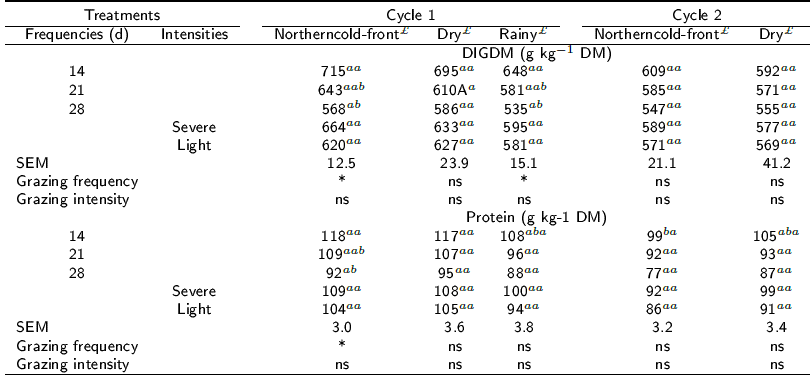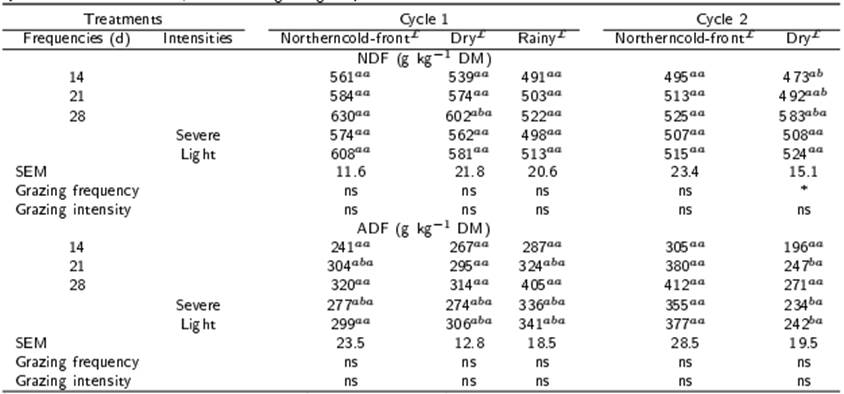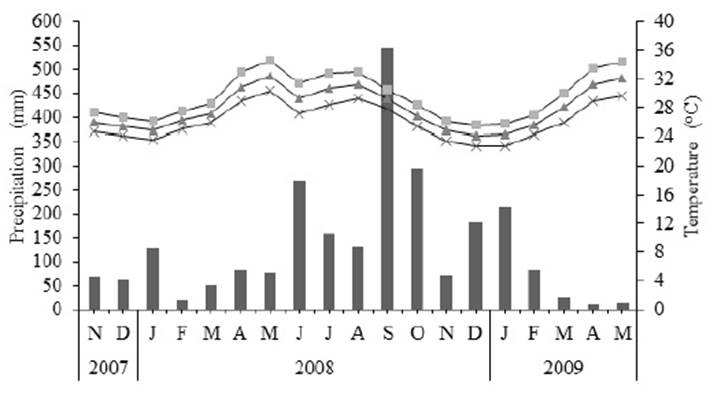Introduction
The production of meat and milk in the tropics mainly depends on forage plants, from which ruminants obtain around 90 % of their nutrients (Difante et al. 2011). Therefore, their management must consider strategies to increase productive and economic eficiency without deteriorating the pasture (Flores et al. 2008). The low productive performance of animals fed with forage plants is associated with inadequate management practices (Nantes et al. 2013). In this regard Barbosa et al. (2007) report that the residual height conducive to eficiently take advantage of Capim-tanzania grass is 25-50 cm, with harvest frequencies at 95 % sunlight intersection by the canopy, while Difante et al. (2011) report that cutting intervals corresponding to when plants have three to four leaves per stem with a residual height of 15 cm require less time for the recovery of Capim-marandu grass. On the other hand, Ribeiro et al. (2001) in studying Tifton-85 grass at different regrowth ages found that the degradation rate of available fibrous carbohydrates was 4.0 to 4.6% h-1 with lower values for plants of greater physiological age. On this, Santana et al.(2010) report 86 to 87 % crude protein in Napier grass (Pennisetum purpureum Schum) in regrowth of 25 and 32 d. Therefore, it is important to know the harvest frequency and intensity to which pasture is subjected, as it is an important component that determines forage production and pasture persistence (Hernández et al. 2002).
The grass Brachiaria hibrido 36061 cv. Mulato is a forage species with excellent nutritional quality, with crude protein concentrations fuctuating between 90 and 170 g kg DM with in vitro digestibility from 550 to 620 g kg DM (Inyang et al. 2010) and yield from 10 to 25 t DM ha-1 year (Argel et al. 2006). These attributes potentiate the grass as an alternative to increase meat and milk production in the tropics, so knowing the response to diferent grazing frequencies and intensities will serve to determine proper harvest timing of harvest without deteriorating the pasture. Therefore, the objective of this study was to evaluate the efect of grazing frequencies and intensities on herbage accumulation and nutritive value of Mulato grass.
Materials and methods
Location of the experiment
The study was conducted from November 2007 to May 2009 in the experimental area of the Academic Division of Agricultural Sciences (DACA) at Juárez Autonomous University of Tabasco (UJAT), located at 17° 46' 56” NL and 92° 57' 28” WL, at 10 m above sea level, located in the municipality of Centro, Tabasco, Mexico, at km 25 of the Villahermosa-Teapa highway. The experimental site has average rainfall of 2010 mm, a mean annual temperature of 27.2 °C, a tropical rainforest climate (Af) (García 1988) and chromic luvisol soil (Palma and Cisneros 1996). Rainfall and temperature data during the experimental period were obtained with weather instruments located in the Academic Division (Figure 1).
Establishment of the pasture
A 37.5 x 48 m area was selected and divided into 18 experimental units of 12.5 x 8 m. Before sowing, 1 L ha-1 of the herbicide Glyphosate at 41 % was applied to eliminate weeds. Mulato grass sowing was done manually in july 2006, for which 6 kg of seeds ha-1 were used, with 50 cm spacing between plants and furrow.
The treatments were randomly distributed in a randomized block design with three replicates, under a 3x2 factorial arrangement, where the factors were grazing frequencies of 14, 21 and 28 d and intensities or residual heights from 9 to 11 (severe) and 13 to 15 cm (light) high. At 15 d before the start of the study, the site was grazed to standardize the residual height proposed in each treatment, for which 10 calves of between 180 and 230 kg liveweight were used, allowing the presence of the animals in the experimental units until reaching the height of the experiment. During the experiment no crop fertilization was performed.
Variables studied
To evaluate herbage accumulation, two fixed frames of 0.5 m2, where all the forage present in the corresponding height was harvested, were randomly placed in each experimental unit one day before the study began. Two cycles were evaluated, the first was from november 2007 to october 2008, and the second from november 2008 to may 2009. In both cycles the northern cold-front (november to february) and dry (march-april) seasons occurred, while the rainy season (june to october) was only considered in the first cycle. For the humid tropical region the occurrence of precipitation and temperature are well defined, so in the present experiment the herbage accumulation for analysis was grouped by seasons. Regarding morphological components (leaf, stems and senescent material), the green forage was weighed and a subsample of about 100 g was obtained and separated into leaf, stem and senescent material, which were deposited in paper bags labelled for subsequent drying in a forced-air oven at 55 °C for 48 h, after which the material was weighed on a Scout® Pro digital scale.
To determine the nutritive value of the harvested forage, in the middle of each season, a 5 kg sample of green forage (100 % leaf) was taken at the corresponding residual height, washed and placed in paper bags to dry them in a forced-air oven at 55 °C for 48 h, after which they were ground in a mill with 1 mm mesh diameter. Protein content (PC) was determined via nitrogen content using the Microkjendhal method (AOAC 1990). Neutral detergent fiber (NDF) and acid detergent fiber (ADF) contents were determined with the methodology of Van Soest et al. (1991). Digestible dry matter (DIGDM) content was determined using the nylon bag technique (Orskov et al. 1980).
Statistical analysis
Statistical analysis of the data was performed using the PROC MIXED procedure of the SAS statistical package (SAS 2001). The effects of intensities and intervals between grazings and their interactions were considered as fixed effects and the effect of blocks as random effect. Comparison of means was performed with the Tukey test at an alpha of 0.05 (Steel and Torrie 1998).
Results
Forage yield
Seasonal and annual accumulation of Mulato (Brachiaria hybrid 36061) grass herbage at different grazing frequencies and intensities is presented in Table 1. Grazing frequency afected herbage accumulation throughout the experiment (p < 0.05). The rainy season accounted for 55 % of herbage accumulation, followed by the northern cold-front and dry seasons with 28 and 16 % of annual yield when harvesting the pasture every 28 d, while increasing the interval between grazings from 14 to 21 and 28 d increased the annual accumulation increased (p < 0.05) by 80 and 165 % in the first evaluation cycle. In the second evaluation cycle, yields were only recorded in the northern cold-front and dry seasons. During the northern cold-front season in the second cycle, yield increased by 69 and 208 % after changing the grazing interval from 14 to 21 and 28 d, respectively.
Tabla 1 Seasonal and annual accumulation of Brachiaria hybrid 36061 cv. Mulato at different grazing frequencies and intensities (kg DM ha-1).

£northern cold-front (november-february), £dry (march-may), £rainy (june-october). Severe (9 to 11 cm) and light (13 to 15 cm). ns= not signifcant; ** p ≤ 0.01; * p ≤ 0.05; abcde= A different lowercase letter in each column indicates difference (p < 0.05); ABCD= A different uppercase letter in each column indicates difference (p < 0.05); SEM= Standard error of the mean.
Grazing intensity showed no significant (p > 0.05) difeerences in the northern cold-front season in the first cycle, but differed signifcantly (p < 0.05) in the other seasons throughout the experiment. The greatest accumulation of Mulato grass occurred with light grazing in all seasons, with a 17 % increase in annual accumulation (p < 0.01) compared to severe grazing in the first cycle; similar behavior was obtained in the second cycle with light grazing, where it was observed that herbage accumulation increased by 22 and 18 % (p < 0.05) with respect to the northern cold-front and dry seasons, respectively.
Nutritive value
The in situ digestibility of dry matter (DIGDM) of Mulato grass had an effect with cutting frequency in the northern cold-front and rainy seasons (p < 0.05) of the first cycle and decreased by increasing the interval between grazings, in all seasons of the year. In the rainy season the DIGDM decreased by 11 and 21 % by increasing the grazing interval from 14 to 21 and 28 d, respectively. In the northern cold-front season, the decrease was 11 and 25 % (first cycle) and 4 and 11 % (second cycle), and in the dry season, the grazing interval of 14 d exceeded by 14 and 19 %, and by 4 and 7 % (p > 0.05) the grazing intervals of 21 and 28 d, in the first and second cycle, respectively (Table 2).
Table 2 Seasonal changes in the content of Digestible Dry Matter (DIGDM) and protein of Brachiaria hybrid 36061 cv. Mulato, at different grazing frequencies and intensities (kg DM ha-1).

£Northern cold-front (nov-feb), £dry (mar-may), £rainy (jun-oct). Severe (9 to 11 cm) and light (13 to 15 cm). ns=not significant; ** p ≤ 0.01; * p ≤ 0.05; abcde= A different lowercase letter in each column indicates difference (p <0.05); ABCD= A different uppercase letter in each column indicates difference (p < 0.05); SEM= Standard error of the mean.
Discussion
Forage yield
Results differ from those obtained by other researchers, who observed a greater effect of the grazing frequency on herbage accumulation and a lesser effect of the defoliation height on different species of grasses (Difante et al. 2011). By subjecting the Mulato grass to a cutting intensity of 9 to 11 cm every 14 d the lowest herbage accumulation was obtained (Table 1); this may be because the interval between defoliations was short and thus did not allow enough time for replenishing the carbohydrate reserves for regrowth (Lara and Pedreida 2011). By grazing at a cutting intensity of 13 to 15 cm, the pasture presented a better response to defoliation and greater herbage accumulation, as noted by Hernández et al. (2002), Difante et al. (2011) and Nantes et al. (2013).
The fact that the greatest herbage accumulation occurred in the rainy season is attributable to favorable rainfall and temperature conditions that stimulated plant growth and yield (Festo et al. 2003). In the northern cold-front season, the rainfall level was not a limiting factor (Figure 1), but rather it was the low temperatures that affected the growth of Mulato grass, which resulted in low forage production (Zanine et al. 2013), while in the dry season, high temperatures and low rainfall inhibited growth, which led to lower forage production (Santos et al. 2013).
Defoliation management influences the rate of growth, production, botanical composition, quality and persistence of the pasture (Difante et al. 2011, Lara and Pedreida 2011, Nante et al. 2013). In this regard, Marcelino et al. (2006) report that the proportion of leaves in the forage decreases as regrowth age increases, which is due to increased stem growth. On this, Barth et al. (2013) report that as the interval between grazings increases, forage yield increases with a smaller contribution of leaves and a higher accumulation of stem and senescent material, which negatively affects the nutritive value of the forage.
Changes in the morphological composition in the rainy season may be due to the fact that soil and climatic conditions favored leaf growth, which coincides with Festo et al. (2003) who found that leaves increase their appearance with temperatures between 20 and 32.5 °C, but decrease when temperatures exceed 35 °C. With regard to the northern cold-front seasons, changes may be because plant growth is inhibited by low temperatures, while during the water stress season the slow growth allowed the harvest of only a little regrowth made up mainly of leaves (Santos et al. 2013). The contribution of stems to the accumulation was increased by increasing the grazing interval from 14 to 28 d. In this respect, Zanine et al. (2013) report that the proportion of leaves in harvested forage decreases with increasing plant age; in the northern cold-front season, stem elongation is inhibited by low temperatures, while in the dry period the wáter deficit is the limiting factor of plant growth (Nantes et al. 2013).
Nutritive value
Results show that changes in DIGDM with increases in grazing frequency were similar to changes in the content of crude protein, since with increasing regrowth age the nutritive value decreases (Inyang et al. 2010, Santana et al. 2010). In this regard, Hernández et al. (2002) note that pastures defoliated on a frequent and severe basis have plants with a higher turnover rate and number of Young leaves, which favors a high CP content and DIGDM with a lower concentration of NDF and ADF (Table 3). Similar effects were observed by Flores et al. (2008) in Marandu and Xaraés grasses where they found the highest values of in vitro digestibility of organic matter and CP in pastures managed at 15 and 25 cm high, while Marcelino et al. (2006) observed that as the defoliation interval increases, the population of stems and senescent material increases, which leads to a low nutritive value of the grass. Mulato grass studies show a decrease in CP content of 16-9% and in vitro digestibility of 62-55%, by increasing the age of the plant from 23 to 30 d (Argel et al. 2005). Similar behavior was observed in the present study by increasing the grazing interval from 14 to 21 and 28 d in all seasons. In this regard, Clavero and Razz (2009) found in maralfalfa grass a 10.35 unit decrease in digestibility by increasing the cutting age from 3 to 9 weeks, while in B. Brizantha by harvesting at 21 and 42 d the digestibility decreases from 61.0 to 47.7 % (Rodríguez et al. 2004). In a grazing production system where forages are the only source of livestock feed, it is important to have adequate pasture management, which means that an increase in regrowth age causes significant changes in soluble, structural components and in the digestibility of the grasses. In this regard, Flores et al. (2008) argue that changes in the structural components cause the nutritive value of grasses to decrease with increasing plant age, as happened with the Mulato grass.
Tabla 3: Seasonal changes in the content of Neutral Detergent Fiber (NDF) and Acid Detergent Fiber (ADF) of Brachiaria hybrid 36061 cv. Mulatto, at different grazing frequencies and intensities.

£northern cold-front (november-february), £dry (march-may), £rainy (june-october). Severe (9 to 11 cm) and light (13 to 15 cm). ns= not signifficant; ** p ≤ 0.01; * p ≤ 0.05; abcde= A different lowercase letter in each column indicates difference (p < 0.05); ABCD= A different uppercase letter in each column indicates difference (p < 0.05); SEM= Standard error of the mean.
Conclusions
The greatest herbage accumulation and content of neutral detergent fiber and acid detergent fiber were recorded by light grazing every 28 d in both cycles. Dry matter digestibility and crude protein showed the highest values by severe grazing every 14 d. In the northern cold-front and dry seasons in both cycles, the highest dry matter digestibility and crude protein content were recorded.











 nova página do texto(beta)
nova página do texto(beta)



